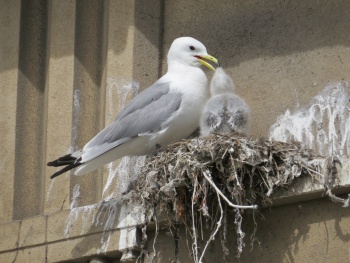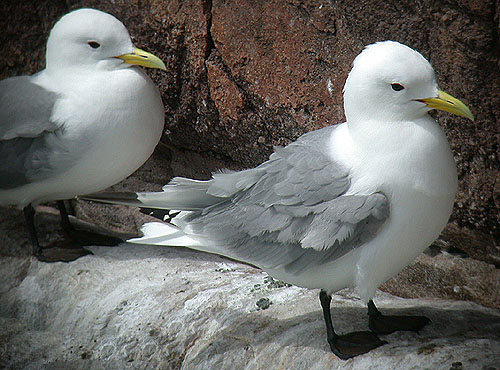Nutcracker (talk | contribs) m (link) |
Nutcracker (talk | contribs) (pic) |
||
| Line 4: | Line 4: | ||
Length 38–40 cm, wingspan 91–120 cm, weight 300–530 g<br /> | Length 38–40 cm, wingspan 91–120 cm, weight 300–530 g<br /> | ||
A medium-sized, usually highly oceanic gull of the northern Atlantic and Pacific Oceans.<br /> | A medium-sized, usually highly oceanic gull of the northern Atlantic and Pacific Oceans.<br /> | ||
| + | [[Image:Kitti 10U2461.jpg|thumb|350px|right|Photo by {{user|rentoncharman|rentoncharman}}<br />[[Bempton Cliffs]], [[Yorkshire]], [[England]], May 2008]] | ||
'''Summer Adult''' | '''Summer Adult''' | ||
*White, with silver-grey mantle and wings | *White, with silver-grey mantle and wings | ||
| Line 22: | Line 23: | ||
====Similar species==== | ====Similar species==== | ||
Adults distinguished from similar-sized gulls like [[Common Gull]] or [[Mew Gull]] by the black wingtips lacking any white 'mirrors' (spots). Juveniles are often confused with [[Sabine's Gull]]s as they have a similar wing pattern, but can be distinguished by their different head pattern, and with experience, their subtly different wing shape and action in flight, typically gull-like unlike Sabine's Gull narrower pointed wings and more tern-like flight. | Adults distinguished from similar-sized gulls like [[Common Gull]] or [[Mew Gull]] by the black wingtips lacking any white 'mirrors' (spots). Juveniles are often confused with [[Sabine's Gull]]s as they have a similar wing pattern, but can be distinguished by their different head pattern, and with experience, their subtly different wing shape and action in flight, typically gull-like unlike Sabine's Gull narrower pointed wings and more tern-like flight. | ||
| − | [[Image: | + | [[Image:Tyne Kittiwake.jpg|thumb|350px|right|Photo by {{user|Nutcracker|Nutcracker}}<br />Newcastle City Guildhall, Newcastle upon Tyne, [[Northumberland]], [[England]], July 2016. The nesting ledge is only about 4 cm wide.]] |
==Distribution== | ==Distribution== | ||
In [[Europe]] breeds around [[Iceland]], the [[Faroes]] and [[Britain]] (absent from much of south and east where coasts lack suitable cliffs), coastal [[Norway]] and the north of the Kola Peninsula. In the far north breeds on [[Jan Mayen]], [[Svalbard]], [[Bear Island]], [[Franz Josef Land]] and [[Novaya Zemlya]]. Also breeds locally in small numbers in northwestern [[Denmark]] and [[Germany]], the [[Channel Islands]] and northwest [[France]], the north-western tip of [[Spain]] and at one site in [[Portugal]]. In the [[North America]]n Atlantic breeds from [[Greenland]], and southern Baffin Island to [[Nova Scotia]] in Canada. The Pacific Ocean populations breed round most of the [[Alaska]]n coast (except the far northeast and far southeast), and round the coast and islands of eastern [[Russia]] from the New Siberian Islands south to the Kurile Islands and Sakhalin. | In [[Europe]] breeds around [[Iceland]], the [[Faroes]] and [[Britain]] (absent from much of south and east where coasts lack suitable cliffs), coastal [[Norway]] and the north of the Kola Peninsula. In the far north breeds on [[Jan Mayen]], [[Svalbard]], [[Bear Island]], [[Franz Josef Land]] and [[Novaya Zemlya]]. Also breeds locally in small numbers in northwestern [[Denmark]] and [[Germany]], the [[Channel Islands]] and northwest [[France]], the north-western tip of [[Spain]] and at one site in [[Portugal]]. In the [[North America]]n Atlantic breeds from [[Greenland]], and southern Baffin Island to [[Nova Scotia]] in Canada. The Pacific Ocean populations breed round most of the [[Alaska]]n coast (except the far northeast and far southeast), and round the coast and islands of eastern [[Russia]] from the New Siberian Islands south to the Kurile Islands and Sakhalin. | ||
| Line 46: | Line 47: | ||
==Behaviour== | ==Behaviour== | ||
====Breeding==== | ====Breeding==== | ||
| − | Breeds on steep sea-cliffs, stacks and rocky islands, in some areas also on buildings. Can build nests on ledges just 4–5 cm wide; narrower ledges are preferred as they give greater safety from predators. | + | Breeds on steep sea-cliffs, stacks and rocky islands, in some areas also on buildings. Can build nests on ledges just 4–5 cm wide; narrower ledges are preferred as they give greater safety from predators. An unusual urban colony is found on the River Tyne in northeast [[England]], where the birds fly 16 km upriver to nest on city centre buildings in Newcastle upon Tyne ([[Northumberland]]) and adjacent Gateshead ([[County Durham]]). |
By far the most abundant gull in the world, with an estimated population of 6–7 million pairs, divided roughly equally between the Atlantic and Pacific Oceans. | By far the most abundant gull in the world, with an estimated population of 6–7 million pairs, divided roughly equally between the Atlantic and Pacific Oceans. | ||
Revision as of 23:58, 11 July 2017
- Rissa tridactyla
Identification
Length 38–40 cm, wingspan 91–120 cm, weight 300–530 g
A medium-sized, usually highly oceanic gull of the northern Atlantic and Pacific Oceans.
Summer Adult
- White, with silver-grey mantle and wings
- Wing tips black ("dipped in ink look")
- Bill yellow with a slight greenish tinge; gape bright red
- Legs dark grey to blackish
- Eye dark brown to black, with a narrow red orbital ring
Winter adult
- As summer except for a variable dark smudge behind the eye
Juvenile & first year
- Black half-collar on rear of neck
- Dark smudge behind the eye
- Black 'W' across wings on outer primaries, secondary coverts, and tertials
- Black bar on tail tip
- Inner primaries and secondaries whiter than adults
- Black bill (turns yellow at about a year old)
Similar species
Adults distinguished from similar-sized gulls like Common Gull or Mew Gull by the black wingtips lacking any white 'mirrors' (spots). Juveniles are often confused with Sabine's Gulls as they have a similar wing pattern, but can be distinguished by their different head pattern, and with experience, their subtly different wing shape and action in flight, typically gull-like unlike Sabine's Gull narrower pointed wings and more tern-like flight.

Newcastle City Guildhall, Newcastle upon Tyne, Northumberland, England, July 2016. The nesting ledge is only about 4 cm wide.
Distribution
In Europe breeds around Iceland, the Faroes and Britain (absent from much of south and east where coasts lack suitable cliffs), coastal Norway and the north of the Kola Peninsula. In the far north breeds on Jan Mayen, Svalbard, Bear Island, Franz Josef Land and Novaya Zemlya. Also breeds locally in small numbers in northwestern Denmark and Germany, the Channel Islands and northwest France, the north-western tip of Spain and at one site in Portugal. In the North American Atlantic breeds from Greenland, and southern Baffin Island to Nova Scotia in Canada. The Pacific Ocean populations breed round most of the Alaskan coast (except the far northeast and far southeast), and round the coast and islands of eastern Russia from the New Siberian Islands south to the Kurile Islands and Sakhalin.
Colonies are occupied from late March (earlier in the south) to early September, dispersing after breeding. In winter occurs widely across mid-latitudes of the Atlantic and Pacific Oceans from the breeding range south to about Morocco and the Mediterranean east to Italy, in the eastern Atlantic, to around Cape Hatteras, North Carolina in the western Atlantic, to Baja California in the eastern Pacific, and to central Japan in the western Pacific. Birds from Britain often cross the Atlantic to feed off Greenland and Newfoundland after the breeding season.
Has occurred as a vagrant to most European countries, the Middle East including Aqaba in Jordan and the Persian Gulf in Oman, north Africa, the Canary and Cape Verde Islands, South Africa, and also to the coasts of China (including two records from Hong Kong) and India, and most inland states in the USA. A truly astonishing record involved an adult in December 2016 on Borit Lake, Gilgit, Pakistan (Birdforum thread) - a remote mountain lake at 36.430°N 74.863°E, 2,650 m altitude and surrounded by the 7,500 m peaks of the Karakoram, 5,000 km from anywhere Kittiwakes usually occur.
Taxonomy
Subspecies
There are 2 subspecies:[1]
- R. t. tridactyla: (Atlantic)
- Northern Atlantic; winters to Saragossa Sea and western Africa
- Wings and back mid-grey. Foot, uniquely among gulls, lacks a hind toe (Latin tridactyla, "three toes").
- Northern Atlantic; winters to Saragossa Sea and western Africa
- R. t. pollicaris: (Pacific)
- Northern Pacific; winters to east China Sea and north-western Mexico
- Wings and back slightly darker grey. Foot with a very small hind toe (Latin pollex, thumb, hence pollicaris, "with a thumb").
- Northern Pacific; winters to east China Sea and north-western Mexico
The two subspecies may not be fully isolated, with e.g. two ringing recoveries of birds from Novaya Zemlya (in the range of the nominate subspecies) in Kamchatka (in the range of R. t. pollicaris). Mixing can be expected to increase as the Arctic ice cap melts with global warming.
Habitat
When not breeding occurs at sea often far from land. Sometimes seen at freshwaters near the coast or far inland after severe weather.
Behaviour
Breeding
Breeds on steep sea-cliffs, stacks and rocky islands, in some areas also on buildings. Can build nests on ledges just 4–5 cm wide; narrower ledges are preferred as they give greater safety from predators. An unusual urban colony is found on the River Tyne in northeast England, where the birds fly 16 km upriver to nest on city centre buildings in Newcastle upon Tyne (Northumberland) and adjacent Gateshead (County Durham).
By far the most abundant gull in the world, with an estimated population of 6–7 million pairs, divided roughly equally between the Atlantic and Pacific Oceans.
Vocalisation
<flashmp3>Rissa tridactyla (song).mp3</flashmp3>
Listen in an external program
References
- Clements, JF. 2009. The Clements Checklist of Birds of the World. 6th ed., with updates to December 2009. Ithaca: Cornell Univ. Press. ISBN 978-0801445019.
- Collins Pocket Guide to British Birds 1966
Recommended Citation
- BirdForum Opus contributors. (2024) Black-legged Kittiwake. In: BirdForum, the forum for wild birds and birding. Retrieved 27 April 2024 from https://www.birdforum.net/opus/Black-legged_Kittiwake






